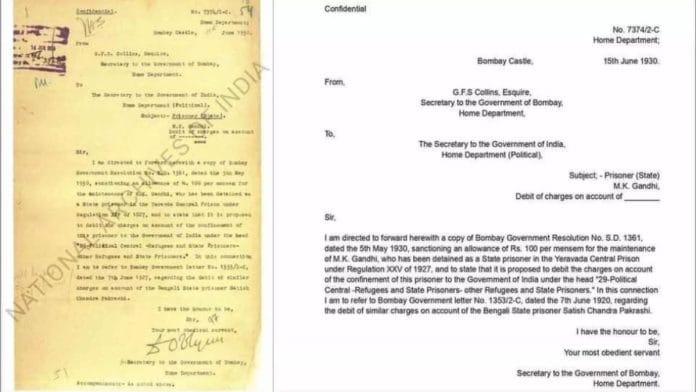Thank you dear subscribers, we are overwhelmed with your response.
Your Turn is a unique section from ThePrint featuring points of view from its subscribers. If you are a subscriber, have a point of view, please send it to us. If not, do subscribe here: https://theprint.in/subscribe/
In the YouTube video titled “Mohandas Karamchand Gandhi: The Most Loyal Defender of the British Empire,” a seldom-explored facet of Gandhi’s political journey is brought to light. This narrative delves into Gandhi’s early years of allegiance to the British Empire, particularly his actions and justifications during the Boer War and World War I, where he actively encouraged Indian support for the British cause.
Gandhi’s commitment to the British Empire initially stemmed from his belief in the British sense of justice and fair play. As a young lawyer in South Africa, he perceived the Empire as a beacon of freedom and equality, which influenced his decision to organize the Indian Ambulance Corps during the Boer War. This act of loyalty was driven by his conviction that such contributions would lead to recognition and subsequent rights for Indians within the Empire.
However, Gandhi’s stance was not merely about blind loyalty. His participation in the recruitment drive during World War I, where he encouraged Indians to enlist in the British Army, was predicated on the promise of post-war political concessions for India. This strategic support was meant to leverage Indian contributions as a bargaining chip for greater autonomy. Gandhi’s advocacy for Indian participation in the war effort was a calculated move, aiming to show the indispensability of Indian support to the British Empire, thereby strengthening India’s position in demanding self-governance.
This period marked a complex phase in Gandhi’s ideology, reflecting a pragmatic approach to achieving long-term goals for Indian independence. Despite his later vehement opposition to British rule and his leadership in the non-violent resistance movement, Gandhi’s earlier years were characterized by a collaborative stance with the British, believing that demonstrating loyalty and indispensable support would earn India the political freedom it sought.
In my essay, “From Satayagraha: Gandhi’s Non-Violent Protests, to Satyayuga: The Age of Governed Truth and Serenity for India’s Golden Age,” I reflect on the transformative power of Gandhi’s principles, drawing parallels between his strategies and the potential for a new era of leadership in India. Gandhi’s concept of satyagraha, a force born out of truth and non-violence, was not just a political tool but a profound moral philosophy. This sentiment echoes the strategic patience Gandhi exhibited during his early years, balancing collaboration and resistance to create a foundation for India’s eventual independence.
As I further elaborate in my essay, the age of Satyayuga envisages a society governed by truth and moral righteousness, drawing inspiration from Gandhi’s unwavering commitment to non-violence and ethical governance. This vision aligns with Gandhi’s strategic actions during his early political career, where he navigated the complexities of colonial politics with a long-term vision for a free and just society.
However, this narrative is not without its critics. Was Gandhi a pacifist only when it suited British interests? Did he stop the Indian troops sent to World War II? No! Did he prevent violence against Indians? No! There’s an untold debate about Gandhi’s support for the Partition of India as approved by the British Congress Party in 1942. And currently, his satyagraha has been weaponized by a certain political party, as I’ve written.
Further critical questions about MK Gandhi:
- Why was he justifying partition from 1942 and did nothing on the British Famine in Bengal?
- Why was he silent on the Kohinoor theft?
- Why did he unilaterally decide on Nehru for Prime Minister when Sardar Patel was duly elected?
- Moreover, why was he given a special allowance by the British for his brief jail stay, equivalent to $1000 per month today?
- Was Veer Savarkar provided this?
- Why was Gandhi’s non-violence stance only non-violent against the British, yet he allowed Indians to fight in WWII against the Germans?
- Where was the pacifism?
- Was it all a geopolitical hoax?
- Did he defend Bhagat Singh?
- Did he prevent the British Famine in Bengal that killed millions?
In essence, the video complements the themes of non-violent resistance and strategic leadership that are central to my narrative. Gandhi’s pragmatic approach, as highlighted in the video, resonates with the vision I articulate for India’s future—a vision rooted in truth, ethical governance, and the cultivation of new leaders who embody these principles. By drawing on historical insights and contemporary reflections, both the video and my essay contribute to a richer understanding of Gandhi’s enduring legacy and its relevance to modern leadership and societal transformation.
For a deeper dive into Gandhi’s political journey and his evolving strategies, you can watch the full video here: https://www.youtube.com/watch?v=-JlERbM7iYM&t=1906s
These pieces are being published as they have been received – they have not been edited/fact-checked by ThePrint.


